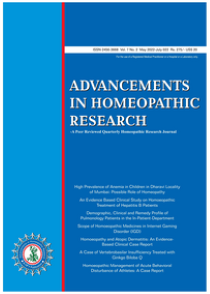Exploring Homoeopathic Interventions in Comorbid Presentation of IgA Nephropathy: A Case Report
DOI:
https://doi.org/10.48165/ahr.2025.10.3.3Keywords:
Nephropathy, prevalent, glomerulonephritis, worldwide, DiseaseAbstract
Introduction: IgA Nephropathy (IgAN) is the most prevalent form ofglomerulonephritis worldwide. Disease progression may lead to advanced chronic kidney disease (CKD) or end stage renal diseases (ESRD). Clinically, IgAN can remain asymptomatic or may present with persistent haematuria and proteinuria. Definitive diagnosis requires renal biopsy. Angiotensin-receptor blockers (ARBs) are commonly used to slow disease progression;however long-term use associated with potential adverse effects. Case summary: This case report presents a patient with symptoms including recurrent urinary tract infections (UTIs) menstrual irregularity, foamy and smoky coloured urine. Laboratory investigations revealed with elevated serum creatinine levels, and a renal biopsy confirmed a diagnosis of IgA nephropathy (IgAN) Thuja occidentalis and Eel serum were found effective in treatment of IgAN. Patients outcomes were assessed using validated tools including the impact outcome related to impact on daily living (ORIDL) and measure yourself medical outcome profile (MYMOP). To evaluate the causal relationship between the intervention and clinical outcomes the Modified Naranjo Criteria for Homoeopathy (MONARCH) inventory was employed. The findings suggest a potential therapeutic benefit of homoeopathic remedies as a part of integrative approach in the management of IgAN, meriting further systematic investigation through controlled clinical studies.
References
Petrou, D., Kalogeropoulos, P., Liapis, G., & Lionaki, S. (2023). IgA nephropathy: Current treatment and new insights. Antibodies (Basel), 12(2), 40.
Rodrigues, J. C., Haas, M., & Reich, H. N. (2017). IgA nephropathy. Clinical Journal of the American Society of Nephrology, 12(4), 677–686.
Habas, E., Ali, E., Farfar, K., et al. (2022). IgA nephropathy pathogenesis and therapy: Review & updates. Medicine (Baltimore), 101(48), e312–319.
Khairwa, A. (2021). Indian scenario of IgA nephropathy: A systematic review and meta-analysis. African Health Sciences, 21(1), 159–165.
Bahall, M. (2017). Use of complementary and alternative medicine by patients with end-stage renal disease on haemodialysis in Trinidad: A descriptive study. BMC Complementary and Alternative Medicine, 17(1), 250.
Schroyens, F. (2009). Synthesis. Treasure edition. Radar Opus Software (2.2.16). Zeus Soft.
Polus, B. I., Kimpton, A. J., & Walsh, M. J. (2011). Use of the measure your medical outcome profile (MYMOP2) and W-BQ12 (Well-Being) outcomes measures to evaluate chiropractic treatment: An observational study. Chiropractic & Manual Therapies, 19(1), 7.
Reilly, D., Mercer, S. W., Bikker, A. P., et al. (2007). Outcome related to the impact on daily living: Preliminary validation of the ORIDL instrument. BMC Health Services Research, 7, 139.
Lamba, C. D., Gupta, V. K., van Haselen, R., et al. (2020). Evaluation of the modified Naranjo criteria for assessing causal attribution of clinical outcome to homeopathic intervention as presented in case reports. Homeopathy, 191–197.
Mahesh, S., Jaggi, L., Jaggi, A., Tsintzas, D., & Vithoulkas, G. (2019). Individualised homeopathic therapy in ANCA-negative rapidly progressive necrotising crescentic glomerulonephritis with severe renal insufficiency: A case report. Journal of Medicine and Life, 12(1), 49–55.
Rasel, N.-E.-A., Alam, M. S., Zahan, M. A.-U.-Z., & Hossain, M. S. E. (2020). Serum creatinine can be reduced by applying homeopathic medicines according to the symptom similarity: Case study analysis of chronic kidney disease (CKD). Journal of Medicine and Life, 12(1), 1–10.
Dandoti, M. H., & Kapse, A. R. (2021). The scope of homoeopathy in improving the quality of life in patients with end-stage renal disease: A case series. Journal of Integrated Standardised Homoeopathy, 4(1), 4–11.
Singh, S., Roja, V., Garg, K., Sehrawat, N., Bhatti, J., & Chakma, A. (2022). Homoeopathy in the management of chronic kidney disease – A narrative review. Indian Journal of Research in Homoeopathy, 16(3), 221–228.
Babu, N. G. (2009). Comprehensive study of Organon (1st ed., pp. 56–57). New Delhi: B. Jain Publishers (P) Ltd.
Boericke, W. (2020). New manual of homoeopathic materia medica with repertory (3rd revised & augmented ed., based on 9th ed., pp. 225, 565–566). New Delhi: B. Jain Publishers (P) Ltd.
Allen, H. C. (2005). Keynotes rearranged and classified with leading remedies of the materia medica with bowel nosodes (10th ed., pp. 312–315). New Delhi: B. Jain Publishers (P) Ltd.
Ross, A. C. G. (1979). Eel serum or Serum Anguillae Ichthyotoxin. British Homoeopathic Journal, 68(4), 227–229.




